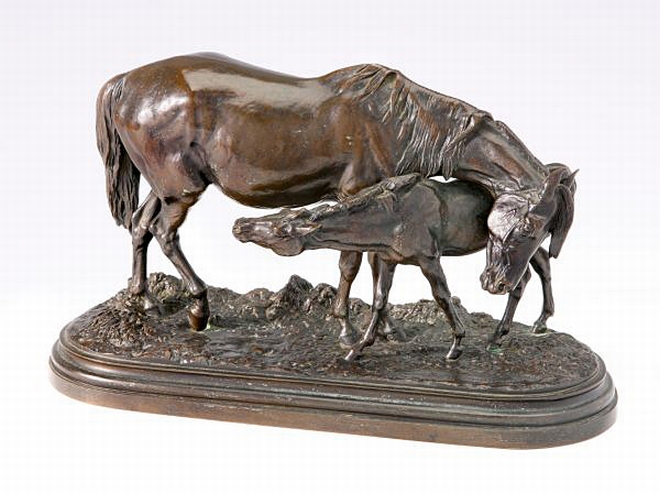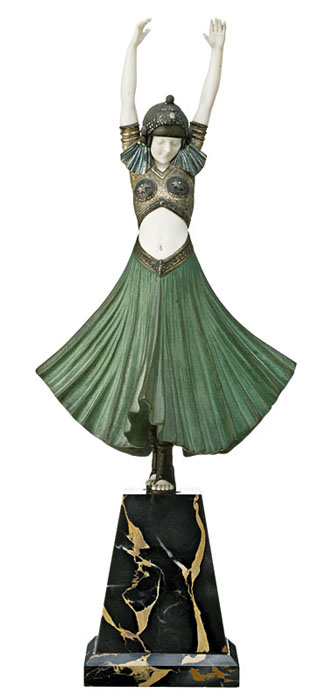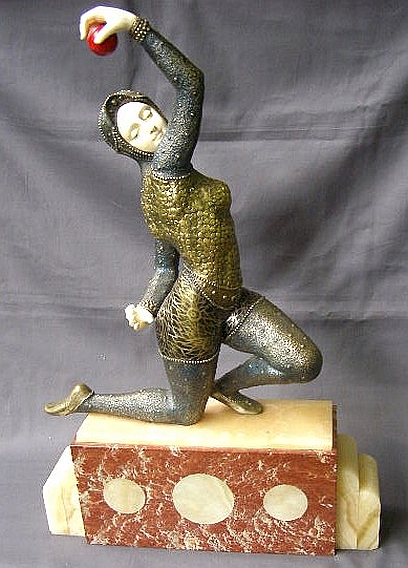Learn about antiques and collectables...
Click on a category below to show all the entries for that category.
Learn about and understand the items, manufacturers, designers and periods as well as the specialist terms used in describing antiques and collectables. Either click one of the letters below to list the items beginning with that letter, or click on a category on the left side of the screen to list the items under that category.
Barye, Antoine Louis and Alfred
Antoine Louis Barye (1796-1875) and his son, Alfred Barye (1839-1882) were French sculptors, most famous for his depiction of animals,
Antoine Louis Barye was born in Paris and took up sculpture in 1817, working in the studios of Bosio & Gros.
In 1819 he took part in the competition of the Ecole des Beaux Arts where he was runner up. Barye exhibited at the Paris Salon from 1827 onwards.
In a career spanning half a century his output was prodigious; his bronzes are imbued with realism and there is meticulous attention to anatomical detail.
Alfred Barye learnt the art of sculpture and casting from his father, but he is always considered subordinate in skills to his father. He is known to have produced numerous casts of famous racehorses of the day, and exhibited a racehorse at the Paris Salon in each of the years from 1864 to 1866.
There is often confusion between the works of the two, as both father and son sometimes used the same signature. A review of the objects on this page will show some signed 'Barye' or 'A. Barye' which could be either the father or son.
Bonheur, Isidore-Jules
Isidore Jules Bonheur (1827-1901) was born in Bordeaux, the third child of Raymond Bonheur and brother of Rosa Bonheur, also a sculptor. In 1849 he enrolled at the Ecole des Beaux Arts, though he had made his debut at the Paris Salon the previous year.
He was both a painter and a sculptor, but is better known for the latter. He produced numerous small bronzes of animals, mainly sheep and cattle, as well as larger studies of groups of horses.
He exhibited regularly at the Royal Academy in London and won a medal in 1889.
Chalkware
Chiparus, Demetre
Romanian-born Demetre Chiparus (1888 – 1950) studied in Italy from 1909 with Raffaello Romanelli and from 1912 in Paris under Antonin Mercie and Jean Boucher and exhibited at the Salon des Artistes Francais sporadically from 1914 to 1928.
Chiparus developed the technique of chryselephantine bronze, (usually a bronze body with ivory face, hands and feet), pioneered in Belgium at the turn of the century, and gave it its peculiar Art Deco character.
He initially produced numerous figures and small groups of children, principally girls, their features carved in ivory set into the bronze, gilded and enamelled. In his later period from the 1920s, as he became more famous, his most notable output were depictions of various dancers in the Art Deco style, leading to huge commercial success.
Chryselephantine
Chryselephantine is not a name for a single material or substance. Originally, chryselephantine was the name given to sculptures made from gold and ivory, a technique in use since the second millenium BC.
The word was derived from a combination of the Greek words for "gold" and "ivory".
Due to the high value of some of the materials used and the perishable nature of others, most chryselephantine statues were destroyed during antiquity and the Middle Ages.
However "chryselephantine" is now used to describe a statue, usually from the Art Nouveau period in which the skin is represented by ivory, and the clothing and other items in the statue are made from another material, most commonly bronze.
A more common way to describe a statue made from these materials would simply be as a "bronze and ivory" [figure].
Other materials used included marble, onyx and silver.
Cold Painted
This is term applied to so-called "Vienna bronzes" manufactured in that city starting in late part of the 19th century, and it continued in the early 20th century, but was also used by sculptors working in other areas of Europe at the time..
Traditionally bronzes are finished by treating them with various acids and chemicals and heats, and the patina is incorporated into the surface of the piece.
A cold-painted bronze is decorated with oil paints. The color was not fired, hence the term "cold painted". Reputedly the painting was carried out mainly by women working at home, a typical cottage industry.
Composition
Composition is a material used for dolls, sculpture and furniture. It is a type of composite material made from a mixture of materials such as sawdust, glue, and pigments. It is a popular material for dolls and figurines because it is lightweight and easy to work with. It is also used in furniture-making, particularly in the construction of decorative pieces such as figurines and sculptures. It is less common in high-end furniture as it is not as durable as some other materials such as wood or metal. However, it is a more affordable and accessible option for some types of decorative pieces.
Ferdinand Barbedienne
Ferdinand Barbedienne, (1810-92) is mostly known for his bronze foundry, which he owned with Achille Collas in 1839 who had invented a method for mechanical size reduction of larger sculptures.
His first castings were reduced versions of antique statues from European museums, and in the mid 1840s began reproducing the work of living sculptors including the animalier sculptor, Antoine Louis Barye and later in the 19th century Auguste Rodin.
On the death of Achille Collas in 1859, Ferdinand Barbedienne became the sole proprietor of the business which at that time employed 300 workers. His work was held in high regard, and he was elected President of the Reunion of Bronze Makers in 1865, a position he held for the next 20 years.
Ferdinand Barbedienne died in 1891 and the business taken over by his nephew Gustave Leblanc who continued the foundry with the high standards set by Barbedienne.
The business closed in 1954.
Works from the foundry are most commonly marked 'Fondeur F. Barbedienne' or similar.
Jules Moigniez
Jules Moigniez (1835-1894) was born in Senlis France. He specialized in game bird and animal sculpture and had considerable fame. All of his bronzes were cast by his father who started a foundry in 1857 for this sole purpose.
Les Animaliers
Les Animaliers is a term used to describe a movement in French sculpture and decorative arts in the late 19th and early 20th centuries that focused on the depiction of animals. The movement was led by a group of artists known as the Animaliers, who were known for their highly realistic and anatomically accurate sculptures of animals. Many of the Animaliers were trained as taxidermists, and their work was influenced by the naturalist movement, which sought to accurately depict the beauty and diversity of the natural world. The Animaliers were particularly known for their bronze sculptures of animals, which were often cast using the lost-wax process and finished with a patina to give them a naturalistic appearance. The Animaliers' work was popular with collectors and the general public, and it continues to be admired for its attention to detail and technical skill.
Mackennal, Edgar Bertram
Born in Melbourne in 1862, MacKennal studied with his father, J.S. MacKennal and at the National Gallery School, Melbourne.
He travelled to England in 1882 studying at the Royal Academy School, London and in Paris, spending five years in the latter city and coming under the influence of French Symbolism and Romanticism. He spent the rest of his working life in London, although he did return to Australia from 1889 to 1892, having won the competition for the decoration of Government House in Victoria.
He exhibited at the Royal Academy from 1886. Prior to his return to Australia he had became head of the Art Department of Coalport Potteries in England.
He executed commissions for the relief carvings in the Victorian Houses of Parliament and for the design of coins. He was knighted in 1921 in recognition of his equestrian portrait of King Edward VII.
MacKennal spent much of his later life in England where he died in 1931.
Vichi, Ferdinando
Ferdinando Vichi (1875-1945) was a central figure in the production of Florentine sculpture at the end of the 19th century.
He is associated with the sculptors Cesare Lapini, Pietro Bazzanti and Guglielmo Pugi, all of whom executed works at The Galleria Bazzanti.
The gallery, originally Bazzanti's studio, was inaugurated in 1822 and is still open today. His compositions are varied in subject matter, ranging from busts after the Antique to Orientalist themes and Renaissance-inspired models.
Like many other late nineteenth-century sculptors, Vichi often took inspiration from classical antiquity. Historicising romantic subjects were very popular in Italian sculpture of the late 19th century


